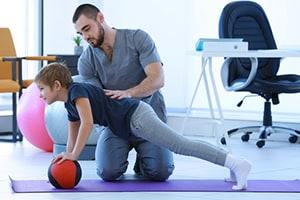Help Center
Online Resource Center for Information on Birth Injuries.

Therapy is the cornerstone of treatment programs for all types of cerebral palsy. Soon after a diagnosis of cerebral palsy, your child will be referred for therapy services in one more of the following modalities: (1) Physical Therapy, (2) Occupational Therapy and/or (3) Speech Therapy. These three therapies are the most commonly prescribed, are covered by insurance (or through early intervention benefits) and are provided in your home, school or in an outpatient setting. These are broad categories under which there are many tools and specific approaches that therapists trained in these fields may use to help your child.
The purpose and objectives behind therapy for children with cerebral palsy is very unique compared to other types of rehabilitative therapies. Children with CP go to therapy to learn adaptive skills to help optimize their functional abilities. This is called “habilitation.” Your child may be prescribed therapy for a certain frequency (i.e number of times per week) and duration, but what your child works on in therapy is expected to be reinforced and practiced in the home, at school, and in the community. It is very important that you be an active partner with your child and their therapist so that you can help them achieve the skills that they are working on. However, it is possible to overdo it.
Physical therapy addresses the child’s general strength, gross motor skills, and mobility. Gross motor skills involve the large muscles of the body. Initial evaluations for physical therapy include looking at the child’s posture, sensory processing, muscle tone, coordination, developmental skills, and adaptive equipment.
For cerebral palsy, there are primary impairments, such as spasticity, quality of movement and postural stability. There are also secondary impairments which are the result of how the primary impairments affect the body and they include things like reduced strength, range of motion limitations and problems with endurance. PTs can help address the secondary impairments of CP. The therapist will help you target body structures and function in order to increase your child’s activity and participation. There are a few different models for providing PT.
Direct physical therapy goals and activities are individually established based on the evaluation and input from the family. They may include learning to sit, crawl, walk, climb steps, or throw or catch a ball. Activities include exercises for strengthening, range of motion, and balance. Simple ball games, tricycle riding, and outdoor play are used to improve coordination and endurance. Physical therapists often work with the family and local medical equipment vendors to identify, order, and maintain adaptive equipment to assist the child’s sitting stability, posture, and/or mobility. Typical equipment includes orthotics, activity chairs, car seats, walkers, special strollers and wheelchairs. Physical therapists also work with the child’s physicians when the child has skin problems-from lack of movement, contractures, or other orthopedic problems.
Parents should become familiar with the GMFCS scale. This scale was developed as an objective way to assess gross motor function in children with CP and to set goals. It’s intended to replace the very subjective terms of “mild”, “moderate” and “severe.” Listed below are some of the commonly used PT techniques and approaches for children with CP. Each physical therapist will differ slightly in education, training, and personal preferences:
Occupational Therapy (OT) refers to all of the “jobs” that make up daily life. An OT evaluates a child’s ability to perform self-care, play, and work/-school skills. These are referred to as ADL’s-activities of daily living. Through a comprehensive evaluation, the OT can identify issues that interfere with a child’s completion of these many skills/tasks. These may include problems with strength, abnormal muscle tone, eye-hand coordination, visual perceptual skills, and sensory processing skills. The goal of OT is for the child to participate as actively and independently as possible in all areas of ADL. Therapy is child-directed and based on activities that are meaningful and purposeful to that specific child and the child’s family.
OTs also assess whether adaptive equipment and assistive technology may increase a child’s independence. Examples include specialized feeding utensils, switches to access computers and electronics, adaptive scissors and writing utensils, splints, and adaptations to clothing such as zipper pulls and button hooks. Pediatric OTs may also provide constraint therapy, sensory integrative (SI) therapy, vision-related therapies, and feeding-related therapy.
Speech pathologists (“SLP”) can foster communication between parents/caregivers and children even when there is little verbal speech. This may include pre-language skills (vocalizations), manual sign language, gestures, picture communication boards, and/or voice output communication devices. These strategies for communicating can reduce your child’s frustration, and increase their opportunities for self-expression.